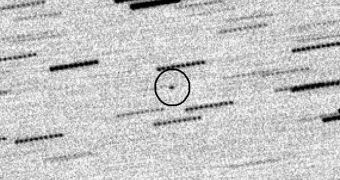Over the past few days, the astronomical community has been in turmoil, as reports indicated that a foreign object was about to make a pass close to the Earth's surface. The weird object was observed by amateur and professional astronomers alike, and many feared that it was somehow a man-made, artificial piece of space debris. However, upon closer inspection, it was determined that the body was a space rock, which is scheduled to zip past our planet at a safe distance today. Even if it enters the atmosphere, researchers say that the chances of it actually impacting the ground are minimal.
At the point of closest approach to our planet, the space rock will still be about one third of the distance between the Earth and the Moon away, or about 80,000 miles (130,000 kilometers) above the ground. This point will be reached at around 7:45 am EST (1245 GMT), and seasoned astronomers may be able to observe it as the asteroid moves across the sky, NASA experts believe. The 36-foot- (11-meter-) wide object was discovered on Monday, and astronomers have dubbed it with another of their catchy names, 2010 AL30, Space reports.
“I looked at this object closely yesterday morning and concluded that this object is probably not artificial,” scientist Paul Chodas, who works at the NASA Jet Propulsion Laboratory (JPL), in Pasadena, California, says. Speaking about initial speculations, which had it that the object was a part of an old spacecraft, the expert says that this is highly unlikely. He also holds an appointment in the JPL Near-Earth Object (NEO) Office, which deals specifically with this type of situations. Chodas reveals that some of the people who said that 2010 AL30 was man-made were influenced in their analysis by the fact that the rock's orbit was precisely one Earth-year long. This is, however, nothing but a coincidence.
For those of you interested in observing the asteroid, know that it will pass through the constellations of Orion, Taurus and Pisces, as it makes its approach and departs our planet's vicinity. According to experts, the body will most likely shine as bright as a 14th magnitude star, so observing it shouldn't be too difficult, if you know where to look. In addition to 2010 AL30, another space rock is to zip past the planet tomorrow. The object, 2010 AG30, will pass about one million kilometers from the surface of the planet, NASA reveals.

 14 DAY TRIAL //
14 DAY TRIAL //